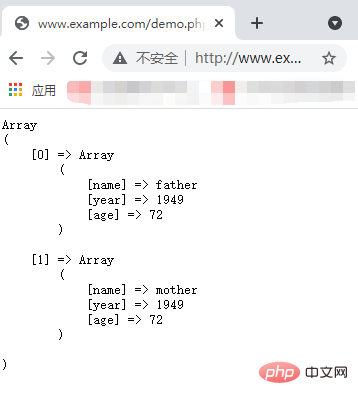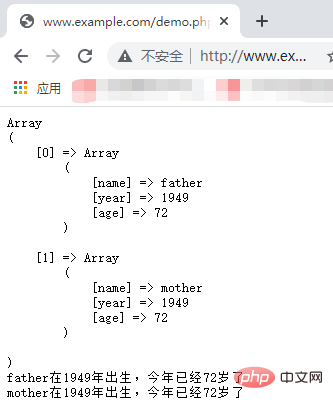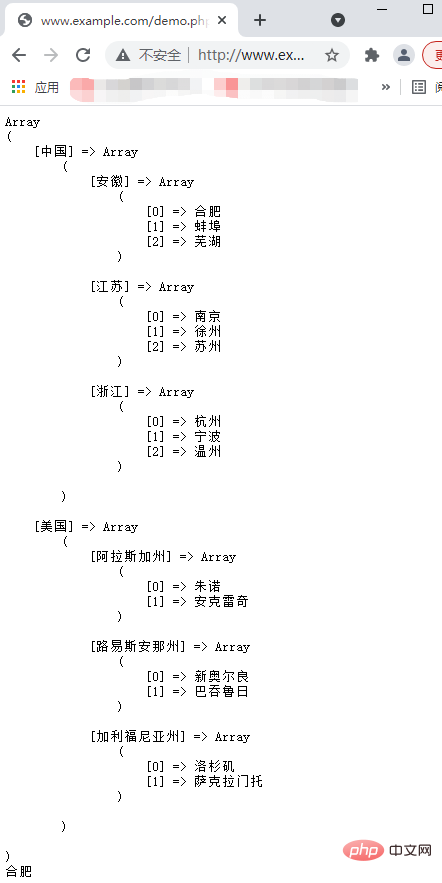 Backend Development
Backend Development
 PHP Problem
PHP Problem
 How to define a multidimensional array and obtain its elements in PHP?
How to define a multidimensional array and obtain its elements in PHP?
How to define a multidimensional array and obtain its elements in PHP?
In the previous article, I brought you "Take you through PHP filters in three minutes (detailed examples)", which introduced the relevant knowledge of PHP filters in detail. In this article, we Let’s take a look at the knowledge related to multi-dimensional arrays in PHP. I hope it will be helpful to everyone!

Through the previous study, we know that arrays in PHP can store all types of data, including of course the array itself. At this time, when the elements in one array are another array, what should we call the array that constitutes the containing array? When the elements in the contained array are still an array, how should we deal with it?
An array is simply a number or a simple list. Sometimes we want to use more than one key to save data. In this case, we need to use the included key we just mentioned. Array, this is called a multi-dimensional array. Next, let’s take a look at the relevant knowledge of multi-dimensional arrays.
Two-dimensional array
As we said above, when the elements in one array are another array, this The arrays that constitute the package function group are two-dimensional arrays, and two-dimensional arrays are simply understood as arrays of arrays. Is its declaration method any different from that of an ordinary array?
The declaration method of two-dimensional array and one-dimensional array is the same, except that one or more elements in the array are also declared as an array. At the same time, there are also direct assignment and use of array elements. The array() function has two ways of declaring a two-dimensional array.
Let's take an example to declare an array by directly assigning values to the array elements. The example is as follows:
<?php
$array[0]['name'] = 'father';
$array[0]['year'] = '1949';
$array[0]['age'] = '72';
$array[1]['name'] = 'mother';
$array[1]['year'] = '1949';
$array[1]['age'] = '72';
echo '<pre class="brush:php;toolbar:false">';
print_r($array);
?>Output result:

In the above example, an array is declared by directly assigning values to the array elements. Next, let’s look at declaring a two-dimensional array through the array() function. In the case of arrays, the example is as follows:
<?php
$array = array(
array('name'=>'father','year'=>'1949','age'=>'72'),
array('name'=>'mother','year'=>'1949','age'=>'72')
);
echo '<pre class="brush:php;toolbar:false">';
print_r($array);
?>The output result is consistent with the output result in the above example.
After declaring a two-digit array, it is very simple to obtain the elements. It is similar to a one-dimensional array. You only need to indicate the subscript of each dimension.
Next, let’s look at how to get the elements in the two-digit array through an example. The example is as follows:
<?php
$array = array(
array('name'=>'father','year'=>'1949','age'=>'72'),
array('name'=>'mother','year'=>'1949','age'=>'72')
);
echo '<pre class="brush:php;toolbar:false">';
print_r($array);
echo $array[0]['name'].'在'.$array[0]['year'].'年出生,今年已经'.$array[0]['age'].'岁了<br/>';
echo $array[1]['name'].'在'.$array[1]['year'].'年出生,今年已经'.$array[1]['age'].'岁了';
?>Output result:

What we need to pay attention to is: the different dimensions of the array indicate that we need to use several subscripts to get the corresponding array elements. For example, a two-dimensional array needs to use two subscripts to get the corresponding array elements, a three-dimensional array requires three, and so on.
Sometimes we want to use more than one key to save data, so we need to use PHP's multi-dimensional array to achieve it. However, sometimes you want to store values with more than one key. At this time, you can use multi-dimensional arrays for storage. Next let's take a look at multidimensional arrays.
Multi-dimensional array
In addition to two-dimensional arrays, PHP also supports three-dimensional arrays, four-dimensional arrays and even more multi-dimensional arrays, which can be collectively referred to here It is a multi-dimensional array, but when the array exceeds three dimensions, its readability will be greatly reduced, and it will not be easy to manage.
Refer to the two-dimensional array and draw inferences. You can easily create a three-dimensional array, a four-dimensional array, or other higher-dimensional arrays. Next, let’s take a look at how a three-dimensional array is defined through an example. The example is as follows:
<?php
$arr = array(
'中国' => array(
'安徽'=>array('合肥','蚌埠','芜湖'),
'江苏'=>array('南京','徐州','苏州'),
'浙江'=>array('杭州','宁波','温州')
),
'美国' => array(
'阿拉斯加州'=>array('朱诺','安克雷奇'),
'路易斯安那州'=>array('新奥尔良','巴吞鲁日'),
'加利福尼亚州'=>array('洛杉矶','萨克拉门托')
)
);
echo '<pre class="brush:php;toolbar:false">';
print_r($arr);
echo $arr['中国']['安徽'][0]; // 输出合肥
?>Output result:

The above example is The definition of multidimensional arrays and how to obtain elements in multidimensional arrays.
If you are interested, you can click on "PHP Video Tutorial" to learn more about PHP knowledge.
The above is the detailed content of How to define a multidimensional array and obtain its elements in PHP?. For more information, please follow other related articles on the PHP Chinese website!

Hot AI Tools

Undresser.AI Undress
AI-powered app for creating realistic nude photos

AI Clothes Remover
Online AI tool for removing clothes from photos.

Undress AI Tool
Undress images for free

Clothoff.io
AI clothes remover

Video Face Swap
Swap faces in any video effortlessly with our completely free AI face swap tool!

Hot Article

Hot Tools

Notepad++7.3.1
Easy-to-use and free code editor

SublimeText3 Chinese version
Chinese version, very easy to use

Zend Studio 13.0.1
Powerful PHP integrated development environment

Dreamweaver CS6
Visual web development tools

SublimeText3 Mac version
God-level code editing software (SublimeText3)

Hot Topics
 PHP 8.4 Installation and Upgrade guide for Ubuntu and Debian
Dec 24, 2024 pm 04:42 PM
PHP 8.4 Installation and Upgrade guide for Ubuntu and Debian
Dec 24, 2024 pm 04:42 PM
PHP 8.4 brings several new features, security improvements, and performance improvements with healthy amounts of feature deprecations and removals. This guide explains how to install PHP 8.4 or upgrade to PHP 8.4 on Ubuntu, Debian, or their derivati
 Explain JSON Web Tokens (JWT) and their use case in PHP APIs.
Apr 05, 2025 am 12:04 AM
Explain JSON Web Tokens (JWT) and their use case in PHP APIs.
Apr 05, 2025 am 12:04 AM
JWT is an open standard based on JSON, used to securely transmit information between parties, mainly for identity authentication and information exchange. 1. JWT consists of three parts: Header, Payload and Signature. 2. The working principle of JWT includes three steps: generating JWT, verifying JWT and parsing Payload. 3. When using JWT for authentication in PHP, JWT can be generated and verified, and user role and permission information can be included in advanced usage. 4. Common errors include signature verification failure, token expiration, and payload oversized. Debugging skills include using debugging tools and logging. 5. Performance optimization and best practices include using appropriate signature algorithms, setting validity periods reasonably,
 How do you parse and process HTML/XML in PHP?
Feb 07, 2025 am 11:57 AM
How do you parse and process HTML/XML in PHP?
Feb 07, 2025 am 11:57 AM
This tutorial demonstrates how to efficiently process XML documents using PHP. XML (eXtensible Markup Language) is a versatile text-based markup language designed for both human readability and machine parsing. It's commonly used for data storage an
 Explain late static binding in PHP (static::).
Apr 03, 2025 am 12:04 AM
Explain late static binding in PHP (static::).
Apr 03, 2025 am 12:04 AM
Static binding (static::) implements late static binding (LSB) in PHP, allowing calling classes to be referenced in static contexts rather than defining classes. 1) The parsing process is performed at runtime, 2) Look up the call class in the inheritance relationship, 3) It may bring performance overhead.
 PHP Program to Count Vowels in a String
Feb 07, 2025 pm 12:12 PM
PHP Program to Count Vowels in a String
Feb 07, 2025 pm 12:12 PM
A string is a sequence of characters, including letters, numbers, and symbols. This tutorial will learn how to calculate the number of vowels in a given string in PHP using different methods. The vowels in English are a, e, i, o, u, and they can be uppercase or lowercase. What is a vowel? Vowels are alphabetic characters that represent a specific pronunciation. There are five vowels in English, including uppercase and lowercase: a, e, i, o, u Example 1 Input: String = "Tutorialspoint" Output: 6 explain The vowels in the string "Tutorialspoint" are u, o, i, a, o, i. There are 6 yuan in total
 What are PHP magic methods (__construct, __destruct, __call, __get, __set, etc.) and provide use cases?
Apr 03, 2025 am 12:03 AM
What are PHP magic methods (__construct, __destruct, __call, __get, __set, etc.) and provide use cases?
Apr 03, 2025 am 12:03 AM
What are the magic methods of PHP? PHP's magic methods include: 1.\_\_construct, used to initialize objects; 2.\_\_destruct, used to clean up resources; 3.\_\_call, handle non-existent method calls; 4.\_\_get, implement dynamic attribute access; 5.\_\_set, implement dynamic attribute settings. These methods are automatically called in certain situations, improving code flexibility and efficiency.
 PHP and Python: Comparing Two Popular Programming Languages
Apr 14, 2025 am 12:13 AM
PHP and Python: Comparing Two Popular Programming Languages
Apr 14, 2025 am 12:13 AM
PHP and Python each have their own advantages, and choose according to project requirements. 1.PHP is suitable for web development, especially for rapid development and maintenance of websites. 2. Python is suitable for data science, machine learning and artificial intelligence, with concise syntax and suitable for beginners.
 PHP: A Key Language for Web Development
Apr 13, 2025 am 12:08 AM
PHP: A Key Language for Web Development
Apr 13, 2025 am 12:08 AM
PHP is a scripting language widely used on the server side, especially suitable for web development. 1.PHP can embed HTML, process HTTP requests and responses, and supports a variety of databases. 2.PHP is used to generate dynamic web content, process form data, access databases, etc., with strong community support and open source resources. 3. PHP is an interpreted language, and the execution process includes lexical analysis, grammatical analysis, compilation and execution. 4.PHP can be combined with MySQL for advanced applications such as user registration systems. 5. When debugging PHP, you can use functions such as error_reporting() and var_dump(). 6. Optimize PHP code to use caching mechanisms, optimize database queries and use built-in functions. 7





